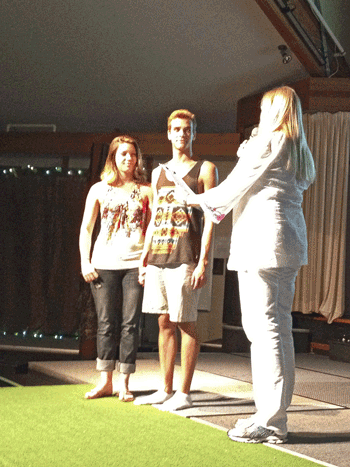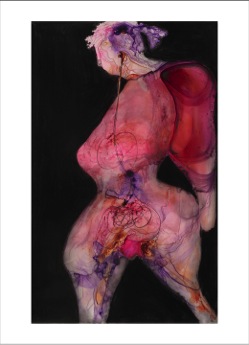Loving in Action at a Ugandan Babies Home
By Gwen Ewan and Cathy Wilder
Gwen and Cathy are members of Haven core faculty and recently volunteered at Sanyu Babies Home in Kampala, Uganda
The jail break happened before our eyes as we entered the compound. They came streaming out of the unlocked side door of the main building, Stuart at the head, a natural leader for any mischief. They were across the recreation yard, through an unfortunately unbarred gate, and up the concrete steps to the back property within heartbeats, lured on by the sound of cackling chickens. Staff were all at morning devotion, so Cathy and I were left to the round-up, picking up children with loaded diapers gingerly, and shooing others along with promises of “mussa, mussa” – breakfast in Lugandan.[1. English is the official language of Uganda. The country was formed by the British colonizers without much consideration of traditional native cultures and homelands. As a result Uganda is made up of many tribes and has many languages. Lugandan is the language of the tribe that traditionally has occupied the area where Kampala now sits.]
Once we had the toddlers rounded up we went to work in the “under one year” nursery for the morning routine with 20 babies. In the space of one hour Cathy and I and two staff members tied up the malaria netting, changed the beds, undressed, bathed, diapered and then dressed the 20 babies. I regularly came out of this marathon dripping wet, not knowing what was bathwater and what was sweat.
Cathy Wilder and I (Gwen Ewan) were volunteers at the Anglican-owned Sanyu Babies Home in Kampala, Uganda last August. The home houses 40 to 45 children under the age of four, although all were under age three when we were there. A few of the children had been dropped off at the home, or some local police station or a hospital, but most were found – at the taxi park, in a toilet, in a field, in a ditch. Some had special needs that must have overwhelmed their family’s abilities to cope. There were no physio services for children such as Matthew who has cerebral palsy. But we saw a volunteer paediatric nurse from the UK stretch and massage Matthew’s tight contracted limbs, so I, and other volunteers, continued to do that.

Many babies arrive badly malnourished or neglected. The professional literature dating back to the 1950s attests to the importance of early stimulation and nutrition for social and cognitive development[2. For example see J. Bowlby Attachment and Loss: Vol. I Attachment (Basic Books, NY, 1969) and R.A. Spitz The First Year of Life (International U. Press, NY, 1965).] and in more recent years with the development of MRIs and other sophisticated diagnostic and research tools, it has become clear that neurological development is also crucially affected by early contact and nutrition. Cathy and I were familiar with this literature, and also had our own experiences working with people who had difficult early life histories. We had no reason to doubt that physical, social and emotional nourishment (or lack thereof) has long term effects on children. Our work at Sanyu Babies gave us another perspective; it showed us evidence that loving contact, basic care and stimulation can have almost immediate impact on physical and cognitive development for tiny children.
Cathy was immediately drawn to Cate – a 10-month-old baby girl who weighed what we might hope for a newborn. In the week of intensive loving that Cathy provided, we saw her go from flat and lifeless to engaged and even smiling. We saw her begin to push her head and then her torso up with her hands, to push and finally kick with her legs and to come off the nasogastric feeding tube and go onto bottle formula. She began to expand from her deeply contracted position of double clasped hands to reaching out with curiosity. We have since heard from the administrator that she continues to progress well and is now sitting, clapping her hands, smiling and playing with her toes. We don’t know if she will catch up developmentally, but at least she had what Cathy could give for a start, and since then she has had others.

I (Gwen) worked closely with two little girls under three months old. Jane did not look malnourished but she threw up everything she took in until experimentation revealed that she could keep formula down if she was given only a few millilitres at a time. She didn’t like this feeding method – she fussed every time the nipple was taken out of her mouth. Other volunteers would feed three or four babies in the time that I could feed Jane, and the staff just didn’t have time for this lengthy process!
Dorothy arrived the second day of our stay at Sanyu Babies. We were told that she had been found in a pit latrine, badly malnourished, and that she was four months old. She looked more like two months, had stick-thin arms and legs and was worrisomely quiet. With the help of a volunteer nurse we lobbied the staff to get agreement to feed her every two hours, and to monitor her intake. I was very concerned to have this extra care continue after we left. I had a very warm and mutually appreciative conversation with the housemother of Dorothy’s nursery. The housemother spoke only a dozen words of English and that was several more than I spoke of Lugandan, but it was, none the less, a meaningful conversation about Dorothy and her needs.

In addition to work in the nurseries, bathing, feeding, changing and playing with the younger children, we worked in the six-to-12-months-old playroom, helped out some with the toddlers and hung and folded endless lines of laundry.

We found that the children were desperate for contact. Our first visit to the home was to drop off the four large duffel bags of formula, diapers, diaper cream, and other supplies that we had brought from Canada.[3. These supplies were either donated, or purchased out of funds donated, by friends here in Canada. The staff were greatly appreciative, and after being with the kids, we can attest to how much they appreciated everything – from dry diapers and creams to toys to powdered formula. The funds not spent on supplies were deposited to the Sanyu Babies Home bank account and subsequently used to pay an outstanding electricity bill, and a one-year supply of milk.] I said hello to little Stuart (the leader of the jail break a week later), patted his head and, after less than one minute of contact, turned to go into the administration building. As I did so, he ran after me holding out his arms. As another volunteer noted, the toddlers actually like getting their diapers changed – it is one-on-one, direct, and kindly contact, and attentive contact is in short supply. The staff did their best to provide stimulation with toys, mirrors at appropriate heights, a home-made “ball pen”, sing-a-longs, and tickles and hugs. There were at least a dozen volunteers working at the home, some for three-month stints, but there still were really not enough adults to give the children the care they needed and certainly not enough long-term contact that they could grow to count on.
I dreamed of crying babies for weeks after we left Sanyu and continue to think about the children lot. Cathy and I were delighted to hear from the administrator that Cate continues to do well, and that both Jane and Dorothy have been adopted. Stuart had an adoptive home before we left. It’s the others that do not have adoptive homes that concern me. We were pleased to discover that Sanyu has a good track record in placing babies – mostly in the US, Canada and UK – and were favourably impressed with the adoptive families that we met who were there to find a child.
Spending a few hours a day for one week with three little girls is one drop of water in the ocean of need. Uganda is a poor country. There are many social problems. There are so many children in so much need. We were told that there are an estimated 2.4 million orphan children in Uganda – a country with approximately the same population as Canada. It would be easy to be discouraged. But the Ugandan people do not seem discouraged; they seem to be happy. In our experience across the entire southern section of the country we found them to be warm, friendly and naturally kind. “Sanyu” is Lugandan for “happy” and, despite the desperate need of these little guys and the frightening circumstances that must have surrounded their birth and early days, these are indeed happy babies. They smiled and laughed and loved to clap hands and to giggle gleefully when getting into mischief.

And we learned yet again that caring about others and the work of caring for them, while painful, is also rewarding – for both the babies and for us. We experienced love in action and we saw these children “extract nourishment out of the air”.[4. Margaret Mahler was a physician who worked extensively with children and developed much of Object Relations Theory. She pointed out that child care is not all one way: there are two people in the mother-child interaction and that a child who might thrive in one environment would fail in another. She described some babies as “able to extract nourishment out of the air” in emotionally impoverished environments. See The Psychological Birth of the Human Infant: Symbiosis and Individuation. (Basic Books, NY, 1975).] It was not enough, and it was what we could do. We felt blessed to have the opportunity to do it and found yet again, that loving is a great privilege.
[print_link]






